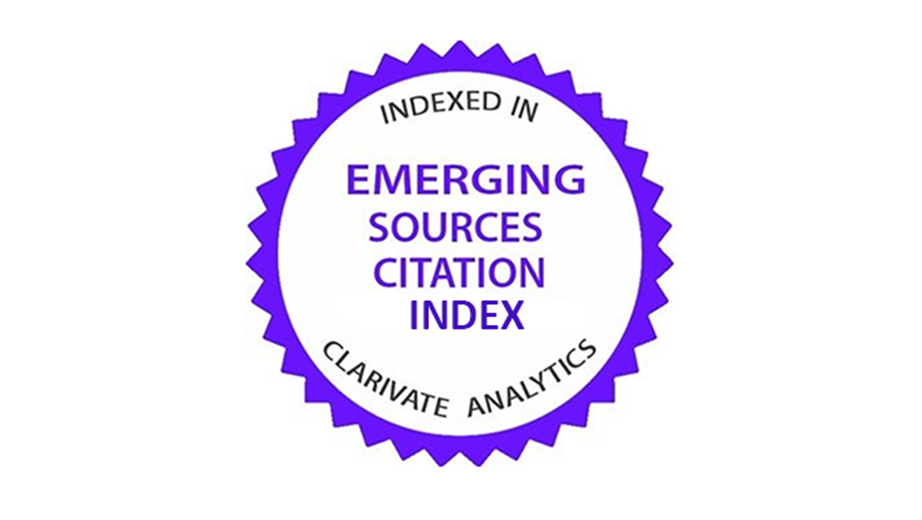Corn Pest Population Dynamics in Organic Systems Following Soybean: A Three-Year Study
Abstract
Keywords
Full Text:
PDFReferences
Acevedo-Siaca, L., & Goldsmith P. D. (2020). Soy-maize crop rotations in Sub-Saharan Africa: A literature review. International Journal of Agronomy, 2020(1), 8833872. https://doi.org/10.1155/2020/8833872
Atapour, M., & Osouli, S. (2021). Effect of different temperatures and hosts on biology of the European corn borer, Ostrinia nubilalis (Hübner), in laboratory conditions. Journal of Agricultural Science and Technology, 23(4), 865–876. Retrieved from http://dorl.net/dor/20.1001.1.16807073.2021.23.4.13.2
Barcanu, E., Agapie, O., Gherase, I., Tănase, B., & Dobre, G. (2023). Evaluating cultivars for organic farming: Tomatoes, peppers and aubergine in South Romania. Agriculture and Food, 11(1), 366–380. https://doi.org/10.62991/AF1996335880
Barrière, Y., Alber, D., Dolstra, O., Lapierre, C., Motto, M., Ordás Pérez, A., ... & Monod, J. P. (2006). Past and prospects of forage maize breeding in Europe. II. History, germplasm evolution and correlative agronomic changes. Maydica, 51 (3–4), 435–449. Retrieved from http://hdl.handle.net/10261/42855
Bažok, R., Lemić, D., Chiarini, F., & Furlan, L. (2021). Western corn rootworm (Diabrotica virgifera virgifera LeConte) in Europe: Current status and sustainable pest management. Insects, 12(3), 195. https://doi.org/10.3390/insects12030195
Boetzl, F. A., Malsher, G., Bommarco, R., & Lundin, O. (2025). Flea beetles in spring oilseed rape differ in phenology and habitat choices for reproduction and overwintering—Implications for pest management. Agricultural and Forest Entomology, 27(2), 241–251. https://doi.org/10.1111/afe.12659
Camerini, G., Groppali, R., Rama, F., & Maini, S. (2015). Semiochemicals of Ostrinia nubilalis: Diel response to sex pheromone and phenylacetaldehyde in open field. Bulletin of Insectology, 68(1), 45–50. Retrieved from https://www.researchgate.net/publication/277931315_Semiochemicals_of_Ostrinia_nubilalis_Diel_response_to_sex_pheromone_and_phenylacetaldehyde_in_open_field
Carrière, Y., Brown, Z., Aglasan, S., Dutilleul, P., Carroll, M., Head, G., ... & Carroll, S. P. (2020). Crop rotation mitigates impacts of corn rootworm resistance to transgenic Bt corn. Proceedings of the National Academy of Sciences, 117(31), 18385–18392. https://doi.org/10.1073/pnas.2003604117
Castro, A. L. G., Latini, A. O., Cruz, I., & Fadini, M. A. M. (2020). Natural control of Helicoverpa armigera (Lepidoptera: Noctuidae) pupae in organic and conventional maize crops. Revista Brasileira de Milho e Sorgo, 19, e1153. https://doi.org/10.18512/1980-6477/rbms.v19n1p16e1153
Climate Data. (2025). Climate Bihor. Retrieved from https://en.climate-data.org/europe/romania/bihor-496/
Corteva Agriscience. (2025). Hybrid P9911. Retrieved from https://www.corteva.ro/produse-si-solutii/seminte-corteva/porumb-pioneer-P9911.html
Costea, M. A., & Grozea, I. (2022). Analysis of the range of pests and their effect on maize plants growing in the organic system. Scientific Papers. Series A. Agronomy, 65(1), 258–265. Retrieved from https://agronomyjournal.usamv.ro/index.php/scientific-papers/past-issues?id=1397
Crista, N. (2007). Research concerning the biology of the pest Helicoverpa armigera Hbn. in maize crops in the western plain conditions. Thesis. Romania: USAMV Timișoara.
Dunbar, M. W., & Gassmann, A. J. (2012). Effect of soybean varieties on survival and fecundity of western corn rootworm. Journal of Economic Entomology, 105(2), 625–631. https://doi.org/10.1603/EC11096
Eckel, C. S., Bradley Jr, J. R., & Van Duyn, J. W. (1993). Soybean yield interaction between Helicoverpa zea infestation and simulated frost injury. Agronomy Journal, 85(2), 232–235. https://doi.org/10.2134/agronj1993.00021962008500020013x
Edwards, C. R., Igrc-Barćic, J., Berger, H. C., Festic, H., Kiss, J., Princzinger, G., … & Vonica, I. (1998). Overview of FAO western corn rootworm containment and control program. IWGO Newsletter, 18(1), 13–14. Retrieved from https://scholar.google.co.id/scholar?hl=id&as_sdt=0%2C5&q=Overview+of+FAO+Western+Corn+Rootworm+containment+and+control+program&btnG=
European Commission. (2020). Communication from the Commission to the European Parliament, the Council, the European Economic and Social Committee and the Committee of the regions. A farm to fork strategy for a fair, healthy and environmentally-friendly food system. Retrieved from https://eur-lex.europa.eu/legal-content/EN/TXT/?uri=CELEX:52020DC0381
Fathipour, Y., & Naseri, B. (2011). Soybean cultivars affecting performance of Helicoverpa armigera (Lepidoptera: Noctuidae). INTECH Open Access Publisher. https://doi.org/10.5772/14838
Furlan, L., Chiarini, F., Contiero, B., Benvegnù, I., Horgan, F. G., Kos, T., ... & Bažok, R. (2022). Risk assessment and area‑wide crop rotation to keep western corn rootworm below damage thresholds and avoid insecticide use in European maize production. Insects, 13(5), 415. https://doi.org/10.3390/insects13050415
Gamage, A., Gangahagedara, R., Gamage, J., Jayasinghe, N., Kodikara, N., Suraweera, P., & Merah, O. (2023). Role of organic farming for achieving sustainability in agriculture. Farming System, 1(1), 100005. https://doi.org/10.1016/j.farsys.2023.100005
Georgescu, E., Cană, L., Gărgăriţă, R., & Râşnoveanu, L. (2015). Current problems concerning flea beetle (Phyllotreta spp.) control from oilseed rape crop, in Romanian Plane. Analele I.N.C.D.A. Fundulea, 83, 157–178. Retrieved from https://www.incda-fundulea.ro/anale/83/83.16.pdf
Gomes, I., González Remuiñán, A., & Freire, D. (2024). Exotic, traditional and hybrid landscapes: Thesubtle history of the Iberian Peninsula maize between‘tradition’ and ‘modernity’. Plants, People, Planet, 6(5), 1047–1059. https://doi.org/10.1002/ppp3.10458
Grozea, I. (2003). Some aspects of corn plants damaged by Diabrotica virgifera virgifera Le Conte species. USAMVB, Lucr. St. Agricultura, Ed. Agroprint Timisoara, 35, 503–507. Retrieved from https://scholar.google.co.id/scholar?hl=id&as_sdt=0%2C5&q=Some+aspects+of+corn+plants+damaged+by+Diabrotica+virgifera+virgifera+Le+Conte+species&btnG=
Grozea, I. (2010). Western corn rootworm (WCR), Diabrotica virgifera virgifera Le Conte-several years of research in western part of Romania. Bulletin of the University of Agricultural Sciences & Veterinary Medicine Cluj-Napoca. Agriculture, 67(1), 122–129. https://doi.org/10.15835/buasvmcn-agr:5022
Hamza, A., Farooq, M., Razaq, M., & Shah, F. (2023). Organic farming of maize crop enhances species evenness and diversity of hexapod predators. Bulletin of Entomological Research, 113(4), 565–573. https://doi.org/10.1017/S000748532300024X
Horgos, H., & Grozea, I. (2020). The current assessment of the structure of Diabrotica virgifera (Coleoptera: Chrysomelidae) populations and the possible correlation of adult coloristic with the type and composition of ingested maize plants. Romanian Agricultural Research, 37, 107–201. Retrieved from https://www.incda-fundulea.ro/new4/images/rar/nr37/rar3723.pdf
Jacoby, R., Peukert, M., Succurro, A., Koprivova, A., & Kopriva, S. (2017). The role of soil microorganisms in plant mineral nutrition—current knowledge and future directions. Frontiers in Plant Science, 8, 1617. https://doi.org/10.3389/fpls.2017.01617
Jat, N., Kumar, S., Shamim, M., Babu, S., Ravisankar, N., & Panwar, A. (2019). Evaluation of maize (Zea mays) cultivars under organic production system in northwestern Indo-Gangetic Plains of India. The Indian Journal of Agricultural Sciences, 89(5), 828–833. https://doi.org/10.56093/ijas.v89i5.89665
Kuepper, G. (2003). Flea beetle: Organic control options. ATTRA Sustainable Agriculture Program, 1–4. Retrieved from https://attradev.ncat.org/wp-content/uploads/2022/08/fleabeetle.pdf
Li, X., Liu, Y., Pei, Z., Tong, G., Yue, J., Li, J., ... & Ban, L. (2023). The efficiency of pest control options against two major sweet corn ear pests in China. Insects, 14(12), 929. https://doi.org/10.3390/insects14120929
Lohaus, K., & Vidal, S. (2013). Nitrogen supply in conventional versus organic farming systems: Effects on the performance of cereal aphids. Organic Agriculture, 3(2), 129–139. https://doi.org/10.1007/s13165-013-0051-1
Lundin, O. (2019). No-till protects spring oilseed rape (Brassica napus L.) against crop damage by flea beetles (Phyllotreta spp.). Agriculture, Ecosystems & Environment, 278, 1–5. https://doi.org/10.1016/j.agee.2019.03.014
Luo, B., Zhou, J., Yao, W., Wang, Y., Guillaume, T., Yuan, M., ... & Zang, H. (2024). Maize and soybean rotation benefits soil quality and organic carbon stock. Journal of Environmental Management, 372, 123352. https://doi.org/10.1016/j.jenvman.2024.123352
Meinke, L. J., Siegfried, B. D., Wright, R. J., & Chandler, L. D. (2025). Long-term suppression of western corn rootworm using crop rotation and field-scale monitoring in organic maize systems. PLoS ONE, 20(2), e0325388. https://doi.org/10.1371/journal.pone.0325388
Meissle, M., Mouron, P., Musa, T., Bigler, F., Pons, X., Vasileiadis, V. P., ... & Oldenburg, E. (2010). Pests, pesticide use and alternative options in European maize production: Current status and future prospects. Journal of Applied Entomology, 134(5), 357–375. https://doi.org/10.1111/j.1439-0418.2009.01491.x
MRA. (2025). Organic corn 2025-2033 analysis: Trends, competitor dynamics, and growth opportunities. Market Research Analysis. Retrieved from https://www.marketreportanalytics.com/reports/organic-corn
Nemecek, T., von Richthofen, J. S., Dubois, G., Casta, P., Charles, R., & Pahl, H. (2008). Environmental impacts of introducing grain legumes into European crop rotations. European Journal of Agronomy, 28(3), 380–393. https://doi.org/10.1016/J.EJA.2007.11.004
Nhung, T. T. P., & Quoc, L. P. T. (2025). Effectiveness of antioxidants and resistance to diamondback moth infestation in green mustard plants using ethanol extracts from Millettia pachyloba Drake leaves: An in vitro and in vivo evaluation. Caraka Tani: Journal of Sustainable Agriculture, 40(1), 109–125. http://dx.doi.org/10.20961/carakatani.v40i1.90957
Nielsen, U. N., Wall, D. H., & Six, J. (2015). Soil biodiversity and the environment. Annual Review of Environment and Resources, 40, 63–90. https://doi.org/10.1146/annurev-environ-102014-021257
Pintilie, P. L., Tălmaciu, M., Trotuș, E., Amarghioalei, R. G., Isticioaia, S-F., Zaharia, R., ... & Popa, L-D. (2022). Research regarding the Ostrinia nubilalis Hbn. (Lepidoptera: Crambidae) attack at maize crops under the central of Moldova conditions, Romania. Romanian Agricultural Research, 39, 497–509. https://doi.org/10.59665/rar3948
Sangakkara, R., Wijesinghel, D., Amarasekera, P., Bandaranayake, S., & Stamp, P. (2012). Growth, yields and nitrogen use of open pollinated and hybrid maize (Zea mays L) as affected by organic matter and its placement in minor seasons of Asia. Maydica, 57(4), 284–292. Retrieved from https://journals-crea.4science.it/index.php/maydica/article/view/889
Simon, J.-C., & Peccoud, J. (2018). Rapid evolution of aphid pests in agricultural environments. Current Opinion in Insect Science, 26, 17–24. https://doi.org/10.1016/j.cois.2017.12.009
Southwood, T. R. E., & Henderson, P. A. (2000). Ecological methods. Third Edition. USA: Blackwell Science. Retrieved from https://scholar.google.co.id/scholar?cluster=3765909372514026269&hl=id&as_sdt=2005&sciodt=0,5
Spencer, J. L., Mabry, T. R., Levine, E., & Isard, S. A. (2021). Soybean foliage consumption reduces adult western corn rootworm (Diabrotica virgifera virgifera) (Coleoptera: Chrysomelidae) survival and stimulates flight. Journal of Economic Entomology, 114(6), 2390–2399. https://doi.org/10.1093/jee/toab167
Suverkropp, B., Dutton, A., Bigler, F., & Lenteren, J. (2008). Oviposition behaviour and egg distribution of the European corn borer, Ostrinia nubilalis, on maize, and its effect on host finding by Trichogramma egg parasitoids. Bulletin of Insectology, 61(2), 303–312. Retrieved from https://archive.bulletinofinsectology.org/pdfarticles/vol61-2008-303-312suverkropp.pdf
Tai-Feng, Z., Yu-Xia, Z., Ying, Y., & Xiang-San, Z. (1993). Variation of transmission potential of BYDV by Rhopalosiphum padi. Virologica Sinica, 8(2), 170. Retrieved from https://www.virosin.org/en/article/id/VS19930802.0170
Tipping, P., Holko, C., & Bean, R. (2005). Helicoverpa zea (Lepidoptera: Noctuidae) dynamics and parasitism in Maryland soybeans. Florida Entomologist, 88(1), 55–60. https://doi.org/10.1653/0015-4040(2005)088[0055:HZLNDA]2.0.CO;2
Török, E., Zieger, S., Rosenthal, J., Földesi, R., Gallé, R., Tscharntke, T., & Batáry, P. (2021). Organic farming supports lower pest infestation, but fewer natural enemies than flower strips. Journal of Applied Ecology, 58(10), 2277–2286. https://doi.org/10.1111/1365-2664.13946
Tóth, M., Csonka, É., Bakcsa, F., Benedek, P., Szarukán, I., Gomboc, S., ... & Ujváry, I. (2007). Species spectrum of flea beetles (Phyllotreta spp., Coleoptera, Chrysomelidae) attracted to allyl isothiocyanate-baited traps. Zeitschrift für Naturforschung C, 62(9–10), 772–778. https://doi.org/10.1515/znc-2007-9-1022
Vörös, L., Ábrahám, R., Solomon, W., & Pinke, G. (2024). Forecasting western corn rootworm (Diabrotica virgifera virgifera LeConte) density and non-chemical control of larvae: A practical review. Agriculture, 14(11), 1959. https://doi.org/10.3390/agriculture14111959
Wallace, J. M., Williams, A., Liebert, J. A., Ackroyd, V. J., Vann, R. A., Curran, W. S., ... & Mirsky, S. B. (2017). Cover crop-based, organic rotational no-till corn and soybean production systems in the mid-Atlantic United States. Agriculture, 7(4), 34. https://doi.org/10.3390/agriculture7040034
Willis, R. B., Abney, M. R., Holmes, G. J., Schultheis, J. R., & Kennedy, G. G. (2010). Influence of preceding crop on wireworm (Coleoptera: Elateridae) abundance in the coastal plain of North Carolina. Journal of Economic Entomology, 103(6), 2087–2093. https://doi.org/10.1603/EC10184
Yadav, S., Sharma, S., Choudhary, R., Jat, G., Yadav, M., Choudhary, R., … & Devatwal, P. (2021). Evaluation of varieties of different types of maize under organic farming. The Indian Journal of Agricultural Sciences, 91(6), 890–894. https://doi.org/10.56093/ijas.v91i6.114294
Yang, M., Yu, J., Wang, Y., Dewer, Y., Huo, Y., Wang, Z., ... & Ma, K. (2025). Potential global distributions of an important aphid pest, Rhopalosiphum padi: Insights from ensemble models with multiple variables. Journal of Economic Entomology, 118(2), 576–588. https://doi.org/10.1093/jee/toae237
Zhang, H. (2023). Effects of soybean–corn rotation on crop yield, economic benefits, and water productivity in the corn belt of Northeast China. Sustainability, 15(14), 11362. https://doi.org/10.3390/su151411362
Zhou, J., Tingting, S., Lingling, S., Kurganova, I., Lopes de Gerenyu, V., Kalinina, O., Giani, L., & Kuzyakov, Y. (2023). Organic carbon accumulation and microbial activities in arable soils after abandonment: A chronosequence study. Geoderma, 435, 116496, https://doi.org/10.1016/j.geoderma.2023.116496
Refbacks
- There are currently no refbacks.











